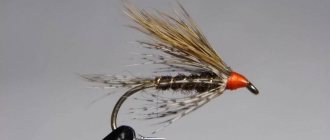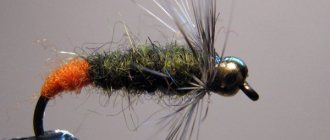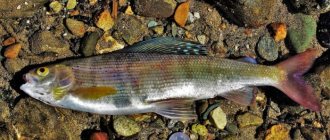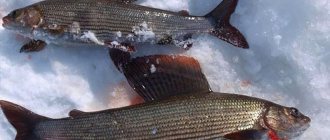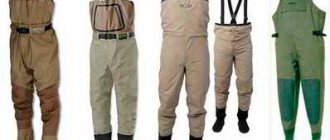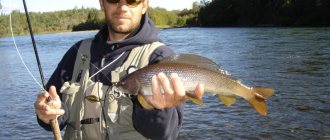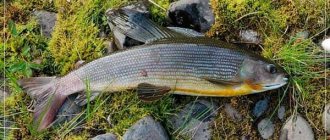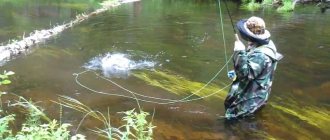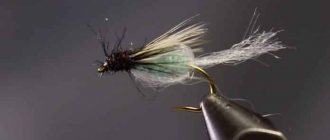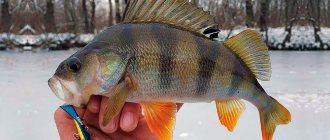- It’s easier to move along the coast in search of promising places;
- There are virtually no midges that can ruin the impression of even the most successful fishing;
- The predator begins to eat.
Therefore, it is worth timing your trip for this amazing fish in September-October.
Tackle for grayling fishing
If you are planning autumn grayling fishing, it’s time to worry about selecting the necessary gear for your trip to the northern regions. After all, it is there, in the cold and swift polar currents, that the desired trophy is found. The choice of possible gear for hunting grayling is quite large. Therefore, it is possible to choose a set based on personal preferences.
Grayling is caught:
- Float tackle;
- Spinning;
- Fly fishing;
- Various types of "donok".
Let us dwell in more detail on the features of equipment, fishing methods and bait.
Preferred stopping places for grayling on the river
Catching grayling with a float rod

Unlike conventional tackle, a float rod, which will be used to catch grayling, is equipped with a special float. It is a hollow transparent ball with a hole. Water is filled into it, thereby achieving the desired weight. There is no additional cargo. The leash is knitted quite long, from a meter to two. Its diameter should be at least 0.2 mm - grayling is a strong fish; when hooked, it opens its upper fin and stubbornly resists.
Almost any insect (butterflies, moths) or an artificial dry fly reminiscent of a caddis fly is suitable as bait.
Fishing method
The finished equipment is released downstream. How far? Here everyone decides for themselves, the main thing is to constantly maintain visual contact with the bait. If the bait suddenly disappears from the surface of the water or a splash appears near it, it is necessary to immediately make a soft but sweeping hook.

Installation of float equipment
Autumn grayling fishing using this method is not much inferior in efficiency to fly fishing. However, it is several times cheaper and can be easily mastered by almost any angler who is at least a little familiar with the “draw” fishing method.
Fishing for grayling using a spinning rod
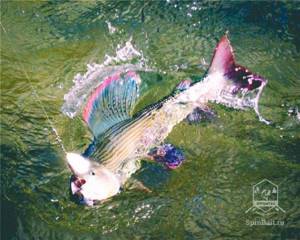
To successfully hunt such a cautious predator, such as grayling, ultralight class rods are used. This is due to the fact that the main bait will be small rotating spoons No. 00 - No. 1. They bear little resemblance to insects that have fallen into the water, and they have no resemblance to artificial flies, but, nevertheless, grayling is perfectly caught with this bait.
Instead of a cord, it is recommended to use monofilament of small diameter, again for the purpose of secrecy. In addition, in this case it is possible to gain extra casting meters (if fishing is done from the shore), which can sometimes become decisive.
It has been noticed that fishing for grayling in September is most successful if silver-colored spinners are used in low light conditions, and copper-colored petals are preferable in sunny conditions.
Small wobblers with a depth of about 0.5-1 m have also proven themselves well.
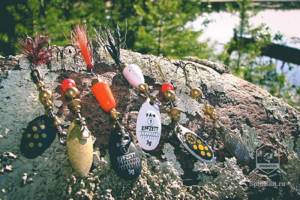
Set of spinning lures for grayling

The cast is made across the current or slightly up. The wiring is uniform and slow. The slowest, at the limit of the bait game. Grayling does not pursue prey for a long time, and if it doesn’t work right away, it will wait for the next time. You can diversify the game of the bait by releasing it downstream. Sometimes this works, especially when the predator is inactive.
Catching grayling with a Tyrolean stick
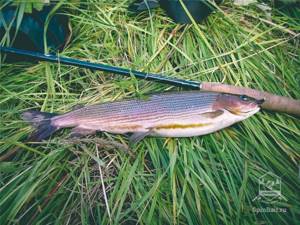
The Tyrolean stick, also known as the jumper, or ballerina, is a hollow tube with a sinker on one end and a winding ring on the other. The tube is made of an inconspicuous material, since grayling has excellent eyesight and, in case of danger, immediately flees. Its main task is to keep artificial flies directly near the bottom, preventing them from floating up and ensuring play in the current.
Making the equipment is quite simple: a piece of fishing line with a diameter of 0.3 mm is attached on one side to the sinker, and at a distance of 40 cm the first outlet for the leash with the fly is attached. After another 40 cm, the second branch (you can install up to four, but optimally two). We measure out the next 40 cm and knit a loop that will connect to the main fishing line - the tackle is ready.
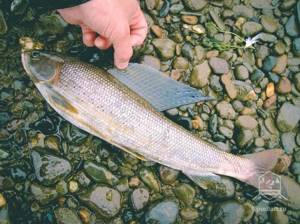
Fishing will definitely bring good results if you have several equipment of different weights with you (the appropriate one is selected directly at the fishing site) and a reserve in case of breaks. In addition, it is necessary to prepare the maximum possible number of flies. Which ones? Old-timers will best answer this question, so take everything you have.
The cast is made over a considerable distance, almost diagonally. When the sinker “hits” the bottom, a slow reeling begins. In this case, the load is carried downstream and it seems to bounce, forcing the bait to play in the stream. Additionally, you can activate the movement of the flies with the tip of the rod. Only two types of wiring are used: slow, uniform, or twitching. The bite is transmitted directly to the rod blank, but distinguishing it from the sinker touching the stones is a matter of experience.
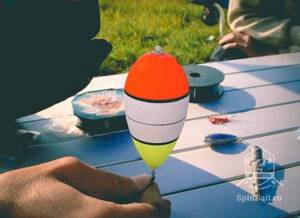
Float for "balda"
Promising fishing spots

So, let us immediately note that during the autumn period grayling does not stay in one place for a long time. It constantly migrates across the pond in search of food. If the routes along which migration occurs are known, then you can already count on catching several trophies. If such information is not available, then you will need to spend a little time searching for active fish. First of all, pay attention to these places:
- areas where the channel narrows, exits from the pool or reach;
- riffles;
- mouths of small rivers and streams;
- deep areas with whirlpools;
- places where small rivers and streams flow into the main channel.
Recommended reading: What is the difference between catfish and burbot
Catching grayling with a balda or bombard
There is still no consensus on the origin of the name. There are two different options, equally plausible:
- Due to the presence of a large float in the equipment;
- The sinker taps the bottom of the river like a bulldozer.
But this is far from the most interesting question. It’s better to move on to a direct consideration of the gear.
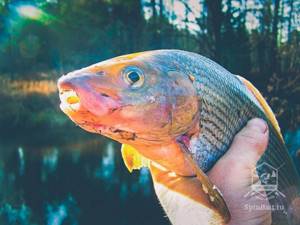
Rod
No high modulus plug sticks! An ordinary Chinese-made composite telescope of medium construction with a decent test, around 50-60 deg. Depending on the fishing method, the length is selected. It is convenient to fish from a boat with a spinning rod of two, maximum two and four meters. When fishing from the shore, the optimal size is 2.4-3.6 m. The only thing you should pay attention to is the guide rings. They must be large in diameter, as the stopper will slip through them. Don’t be too lazy to modify the purchased rod yourself and in the future you will save on equipment by avoiding annoying “shootings” when casting.
Coil
You can use a multiplier, but it is quite expensive (this requires the purchase of a special fishing rod). If you are an experienced fisherman, then you probably still have an old but reliable Nevskaya inertial reel - take it, my dear one. If not, then look for an analogue (Chinese is possible). The most important thing is the presence of a good rolling bearing and a large spool capable of holding 130-150 meters of fishing line with a diameter of 0.4 mm. You will have to practice a little in casting, braking and controlling the line being released. But the future trophy is worth such efforts!
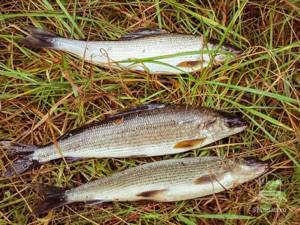
fishing line
Fishing conditions require the use of a main line of at least 0.35-0.4 mm. For equipment, take a fishing line with a diameter of 0.25-0.3 mm. The leashes are knitted with a length of about 15-20 cm (but this can later be adjusted based on the experience gained and specific fishing conditions) from a fishing line with a diameter of no more than 0.15-0.2 mm.
Sinker
Either pear-shaped or elongated are used. It is not the shape itself that is important, but the correct selection of weight (especially its proportionality to the float).
Float
The shape and size are almost arbitrary. Here you can show your imagination, but you must adhere to certain rules. The float must be large because its behavior will have to be monitored over long distances (about 70-100 m). The lower part must be black or dark in color - grayling is a cautious fish and should not be frightened again.
Installation of gear
The main line is wound onto the reel. The upper stopper of the float is installed: it must be reliable and at the same time slide freely through the passage rings. A float is put on (it is sometimes called a float), and a carabiner is tied at the end for attaching the equipment (aka a setup, a post). The rig itself is a piece of fishing line with leads on which artificial flies (mostly white, gray, brown) are attached, and a sinker. It is recommended to attach the latter to a line of smaller diameter - in case of a snag, only the sinker is lost.

Fishing method
A long cast upstream is performed (casting angle approximately 60-70 degrees). The distance between the float and the sinker should be greater than the depth of the reservoir. The load falls to the bottom, the float is leveled - we take out the slack. The force of the current pulls the float, which, in turn, drags the sinker along the bottom, raising a tempting turbidity. The ideal angle of attack (set position between the sinker and the float) is 45 degrees. The equipment is released downstream 60-70 meters and, if there is no bite, is exhausted. Bites are registered by the behavior of the float, and the hook should be sweeping and immediate. The ability to detect a bite comes with experience, as long as you hook it a little with any non-standard maneuver of your alarm. If you don't catch it, at least you'll stay warm. Fishing from a boat differs only in the absence of the need to cast long distances.
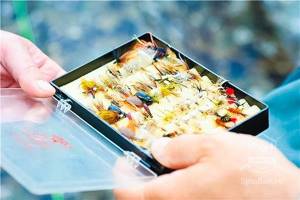
Set of fly fishing flies
Equipment
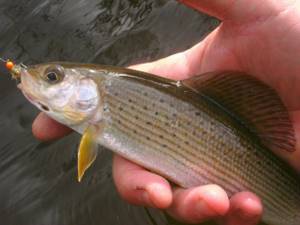
At this time, it can be caught in muddy water by fishing for a worm, bark beetle larva, or fry. Tackle for catching grayling in the fall should have a medium action rod and a light spinning reel. Many fishermen who know what and how to catch grayling in the fall use a line with a diameter of 0.25 millimeters as the main line and 0.17 mm for the leader. The sinker should have two or three pellets attached thirty centimeters from the fifth or seventh hook (domestic numbering).
Fly fishing
When fly fishing for grayling in the fall, good results can be achieved by simply releasing the bait with the current. Thanks to the features of this method (the cord is always controlled by the fisherman’s hand), you can feel the bite even at a considerable distance. To successfully catch grayling in September, it is worth using flies of dark, gray, and sometimes black colors. The best results are obtained by imitating caddisflies and stoneflies.
If you were lucky enough to catch grayling on one of the rivers in the northern region of our country, then you will never forget this trip. After all, in addition to wonderful fishing, you pass a kind of test for survival in the wild. It’s not without reason that they say: “You need to fish where it is, and where there are no people.”
Fishing technique and tactics
There are several techniques for catching this fish.
- On a float rod. You must choose a fishing rod whose length reaches up to 5 m. The main fishing line should be 0.15 to 0.30 millimeters in size. The weight must be attached to the closest float and balanced in such a way as to create the best sensitivity. Next you need to secure the leash and then the hook. The hook will fit number 5-6.
Do not choose thin hooks. This is explained by the fact that grayling has very thin lips and when fishing, you can simply tear them.In winter, it is best to use worms and maggots as bait.
- Spinning fishing. The spinning rod is suitable with a dough of up to 7 g. The fishing line must be braided, measuring from 0.10 to 0.15 cm. This will allow you to make long casts. Use spinners and wobblers as bait.
- Fly fishing. In this case, it is necessary to use light class rods. A floating cord must be selected from seventh to eighth grade. If you plan to hunt big fish, then choose thick leaders.
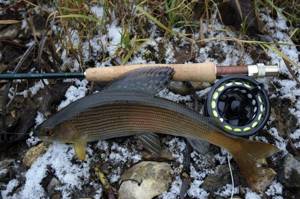
Initially, fly fishing began with catching fish such as trout, salmon and grayling. Therefore, fly fishing for grayling is a classic.
- "On the boat ." This technique is fishing using a boat, along with a fly of any other line on which the fishing line is wound.
